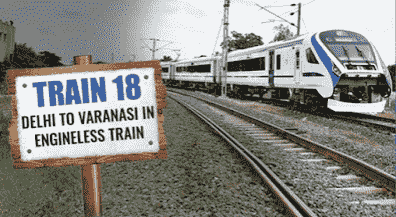Indian Railways has always been the backbone of the nation’s transport system, connecting people and places across the country. Among its recent innovations, Train 18 stood out as a landmark achievement. Known for its advanced technology, modern design, and passenger-friendly amenities, it quickly became the face of a new-age railway system. But in line with India’s cultural aspirations and national vision, Train 18 has been renamed as Vande Bharat Express– a name that resonates with pride and patriotism.
Train 18 Renamed: Why the Change?
The Ministry of Railways announced that Train 18 is now officially called Vande Bharat Express. The new name reflects the train’s proud ‘Made in India’ status, showcasing India’s capability to design and manufacture world-class trains within its own borders.
The then Railway Minister hailed this development as a significant step toward realising the dream of a “New India.” Built under the Make in India initiative, Train 18 was designed and manufactured in a record 18 months, making it a remarkable engineering milestone for the Indian Railways.
Vande Bharat Express – India’s First Semi High-Speed Train
With the renaming, Vande Bharat Express takes its place as India’s first semi-high-speed train, symbolising speed, comfort, and innovation. Capable of running at a maximum speed of 160 kmph, the train significantly reduces travel time across major routes.
For instance:
New Delhi to Varanasi: Travel time reduced to about 8 hours , almost 40%-50% faster than the fastest existing trains.
Other major routes are also witnessing similar travel time cuts, ranging from 25% to 45%.
This time-saving feature makes Vande Bharat Express a preferred choice for both business and leisure travellers.
Key Features of Vande Bharat Express (Formerly Train 18)
The transformation of Train 18 into Vande Bharat Express is not just in its name but also in the passenger experience it offers. Some of the world-class features include:
- Onboard Wi-Fi & Entertainment for a connected journey.
- GPS-based Passenger Information System for real-time updates.
- CCTV Surveillance for enhanced safety.
- Bio-vacuum Toilets similar to those found in airplanes.
- Rotating Chairs in Executive Class for extra comfort.
- Facilities for Disabled Passengers ensuring inclusivity.
- 16-Coach Chair Car Setup including 2 Executive Class and 14 Chair Cars.
- Eco-Friendly and Energy Efficient
One of the most remarkable aspects of Vande Bharat Express is its intelligent braking system with power regeneration, which makes it highly energy-efficient and eco-friendly. The technology reduces energy consumption and operational costs, making it a sustainable choice for the future.
This innovation has even attracted global attention, with countries like France expressing interest due to its affordability and efficiency.
Train 18 Renamed – A Symbol of National Pride
The renaming of Train 18 to Vande Bharat Express is more than just a change of title; it reflects India’s progress in modern railway technology and its self-reliance in manufacturing. The name “Vande Bharat” resonates with cultural pride and the spirit of a self-sufficient India.
Indian Railways continues to expand the network of Vande Bharat Express trains, ensuring faster connectivity and enhanced passenger experience across the country.
